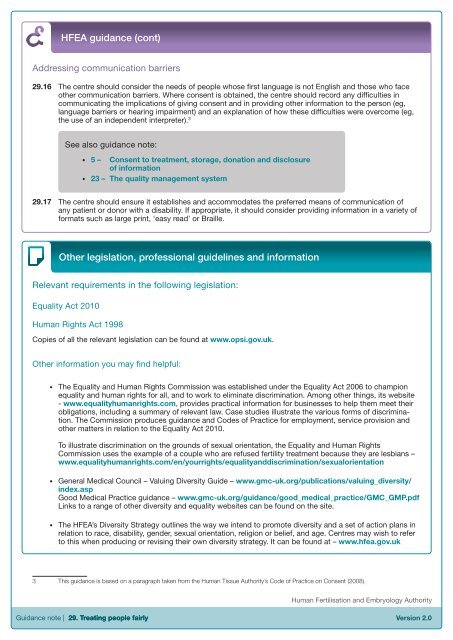Eighth Edition - R.3 - Human Fertilisation & Embryology Authority
Eighth Edition - R.3 - Human Fertilisation & Embryology Authority
Eighth Edition - R.3 - Human Fertilisation & Embryology Authority
Create successful ePaper yourself
Turn your PDF publications into a flip-book with our unique Google optimized e-Paper software.
HFEA guidance (cont)<br />
Addressing communication barriers<br />
29.16 The centre should consider the needs of people whose first language is not English and those who face<br />
other communication barriers. Where consent is obtained, the centre should record any difficulties in<br />
communicating the implications of giving consent and in providing other information to the person (eg,<br />
language barriers or hearing impairment) and an explanation of how these difficulties were overcome (eg,<br />
the use of an independent interpreter). 3<br />
See also guidance note:<br />
• 5 – Consent to treatment, storage, donation and disclosure<br />
of information<br />
• 23 – The quality management system<br />
29.17 The centre should ensure it establishes and accommodates the preferred means of communication of<br />
any patient or donor with a disability. If appropriate, it should consider providing information in a variety of<br />
formats such as large print, ‘easy read’ or Braille.<br />
Other legislation, professional guidelines and information<br />
Relevant requirements in the following legislation:<br />
Equality Act 2010<br />
<strong>Human</strong> Rights Act 1998<br />
Copies of all the relevant legislation can be found at www.opsi.gov.uk.<br />
Other information you may find helpful:<br />
• The Equality and <strong>Human</strong> Rights Commission was established under the Equality Act 2006 to champion<br />
equality and human rights for all, and to work to eliminate discrimination. Among other things, its website<br />
- www.equalityhumanrights.com, provides practical information for businesses to help them meet their<br />
obligations, including a summary of relevant law. Case studies illustrate the various forms of discrimination.<br />
The Commission produces guidance and Codes of Practice for employment, service provision and<br />
other matters in relation to the Equality Act 2010.<br />
To illustrate discrimination on the grounds of sexual orientation, the Equality and <strong>Human</strong> Rights<br />
Commission uses the example of a couple who are refused fertility treatment because they are lesbians –<br />
www.equalityhumanrights.com/en/yourrights/equalityanddiscrimination/sexualorientation<br />
• General Medical Council – Valuing Diversity Guide – www.gmc-uk.org/publications/valuing_diversity/<br />
index.asp<br />
Good Medical Practice guidance – www.gmc-uk.org/guidance/good_medical_practice/GMC_GMP.pdf<br />
Links to a range of other diversity and equality websites can be found on the site.<br />
• The HFEA’s Diversity Strategy outlines the way we intend to promote diversity and a set of action plans in<br />
relation to race, disability, gender, sexual orientation, religion or belief, and age. Centres may wish to refer<br />
to this when producing or revising their own diversity strategy. It can be found at – www.hfea.gov.uk<br />
3 This guidance is based on a paragraph taken from the <strong>Human</strong> Tissue <strong>Authority</strong>’s Code of Practice on Consent (2008).<br />
<strong>Human</strong> <strong>Fertilisation</strong> and <strong>Embryology</strong> <strong>Authority</strong><br />
Guidance note | 29. Treating people fairly<br />
Version 2.0

















